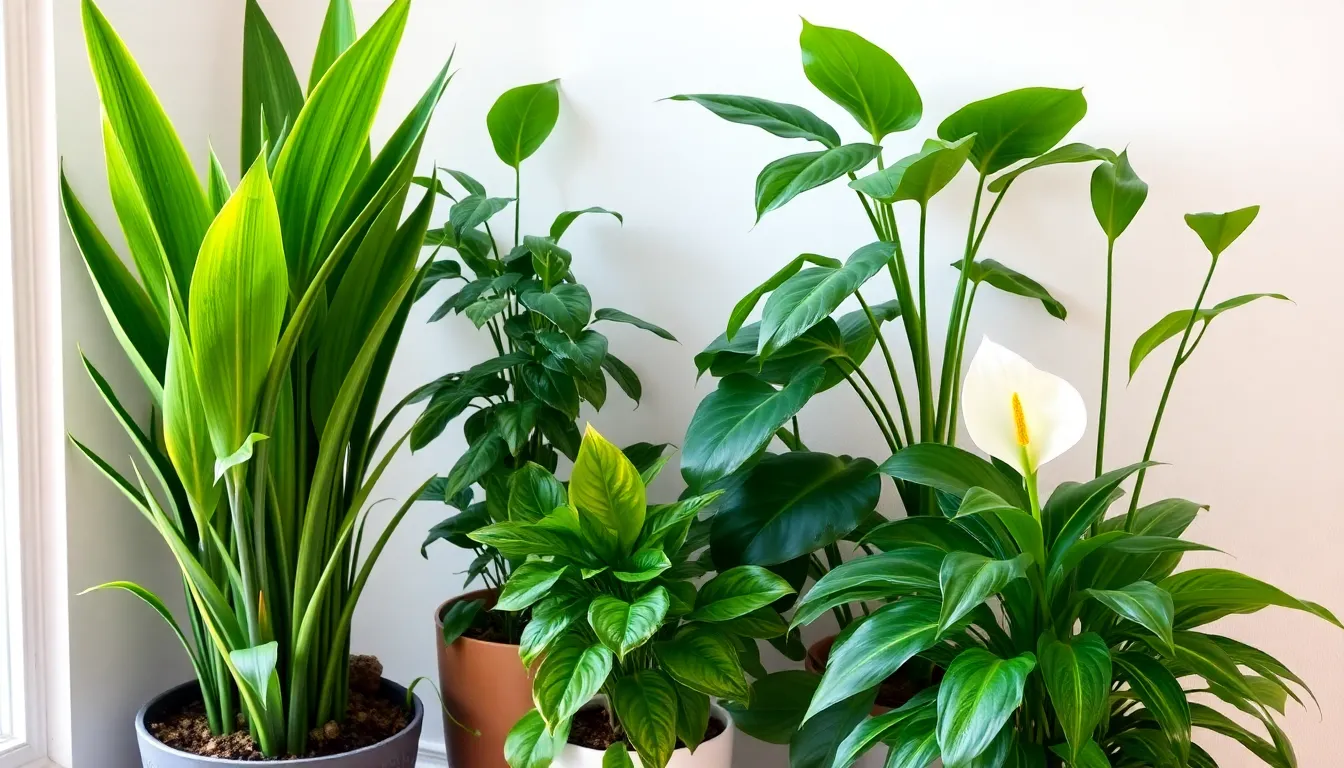
Best Low Light Houseplants: Thrive in Dim Spaces & Boost Your Mood
If the thought of keeping plants alive feels like a high-stakes game of survival, fear not! Low light houseplants are here to save the day, proving that even the darkest corners of your home can thrive with a splash of greenery. These green warriors don’t need a sunbathing session to flourish; they’re perfectly content soaking up the dim light while adding a touch of life to your space.
Best Low Light Houseplants
Low light houseplants offer several advantages for indoor environments. They improve air quality by filtering toxins and releasing oxygen. For instance, plants like the peace lily and pothos effectively reduce pollutants, creating a healthier living space.
Another benefit lies in their versatility. These plants adapt well to various locations in a home, from dark corners to offices with limited light. Their ability to thrive in indirect sunlight makes them a great choice for areas where traditional plants struggle.
Moreover, low light houseplants require minimal maintenance. They often need infrequent watering and can survive longer periods without attention. For busy individuals, this ease of care simplifies plant ownership, allowing for a green touch without significant commitment.
Additionally, these plants enhance aesthetics. They add color and texture to rooms that may otherwise feel dull or sterile. Varieties such as snake plants and ZZ plants bring visual appeal without the need for bright lighting.
Lastly, incorporating low light houseplants can boost mood and productivity. Studies show that being around greenery can reduce stress levels and increase feelings of well-being. Even in low-light conditions, their presence can uplift spirits and enhance focus.
Choosing low light houseplants not only brightens a space but also contributes to overall mental and physical health.
Top Low Light Houseplants

Low light houseplants thrive in dim conditions, adding life to any space. Here are some of the best options:
Snake Plant
Snake plants, also known as Sansevieria, tolerate neglect and thrive in low light. They possess tall, sword-shaped leaves that can grow up to 4 feet long. These hardy plants filter indoor air pollutants, enhancing air quality. Watering occurs infrequently, allowing them to store moisture. Snake plants adapt well to various environments, making them ideal for homes and offices.
Pothos
Pothos, or Epipremnum aureum, features trailing vines that can reach lengths of 10 feet. This versatile plant grows well in low light, thriving in various conditions. Its heart-shaped leaves, available in different colors, brighten any room. Pothos can tolerate irregular watering; they prefer to dry out between sessions. Hanging planters display their attractive foliage beautifully.
ZZ Plant
ZZ plants, known for their glossy leaves, tolerate low light and minimal water. Zamioculcas zamiifolia can grow up to 3 feet tall, creating an appealing presence. This plant stores water in its thick stems, making it drought-resistant. As a low-maintenance option, ZZ plants are perfect for busy individuals. Their unique foliage adds elegance to any indoor setting.
Peace Lily
Peace lilies, or Spathiphyllum, feature stunning white blooms and rich green leaves. They thrive in low light, making them suitable for shadier spots. These plants actively remove toxins from the air, improving indoor air quality. Regular watering keeps them healthy, but they’ll droop slightly when thirsty. Peace lilies not only enhance spaces aesthetically but also promote well-being.
Spider Plant
Spider plants, scientifically known as Chlorophytum comosum, display long, arching leaves. They adapt easily to low light and are resilient in various conditions. Known for their air-purifying qualities, they remove harmful substances from the air. Regular watering helps maintain their vibrant appearance. Spider plants produce “pups,” allowing for easy propagation and expansion of greenery in the home.
Care Tips For Low Light Houseplants
Caring for low light houseplants helps ensure they thrive in dim conditions. These plants adapt to lower light levels, making their care straightforward.
Light Requirements
Low light houseplants thrive in indirect sunlight or artificial light. Placing them near a north-facing window suits many varieties. Even fluorescent lights can provide adequate illumination. It’s essential to avoid direct sunlight, as intense rays can scorch leaves. Positioning plants 3 to 6 feet away from windows often yields the best results. Monitoring their growth reflects how well they’re adjusting to the light conditions.
Watering Guidelines
Watering low light houseplants requires attention to their specific needs. Overwatering presents a significant risk, leading to root rot. Allowing the top inch of soil to dry before the next watering encourages healthy growth. Generally, watering every 1 to 2 weeks suffices, but individual plant needs may vary. Observing the leaves offers insight; yellowing could indicate overwatering, while drooping signals a need for water. Adjusting the watering schedule based on seasons helps maintain optimal moisture levels.
Soil Recommendations
Choosing the right soil mix contributes significantly to the health of low light houseplants. A well-draining potting mix promotes aeration and prevents waterlogging. Many opt for a blend of potting soil, perlite, and peat moss for optimal drainage. Lightweight and rich in nutrients, such a mixture supports healthy root development. Ensuring the pot has drainage holes prevents excess moisture from accumulating. Repotting every year or two encourages vigorous growth and refreshes nutrient levels.
Conclusion
Incorporating low light houseplants into a home brings numerous benefits beyond just aesthetics. These resilient plants thrive in dim conditions and require minimal care, making them perfect for busy lifestyles. They not only enhance indoor air quality but also contribute to improved mental well-being. With a variety of options available, from snake plants to peace lilies, there’s a perfect fit for every space. By choosing the right low light plants and following simple care tips, anyone can enjoy the beauty and health benefits that greenery provides. Embracing these plants can transform any dull area into a vibrant oasis.
